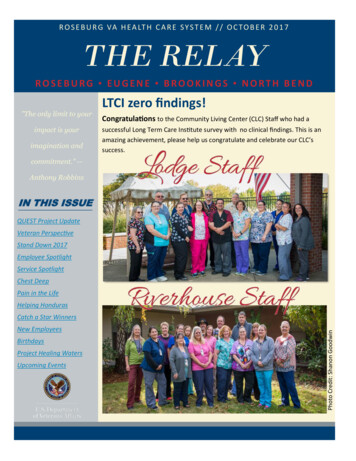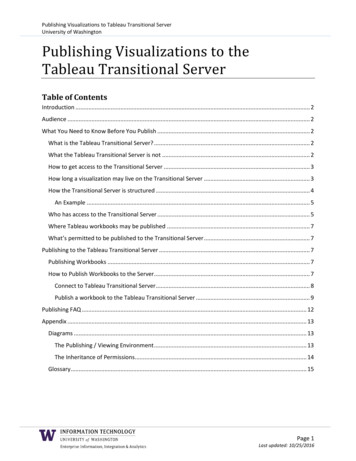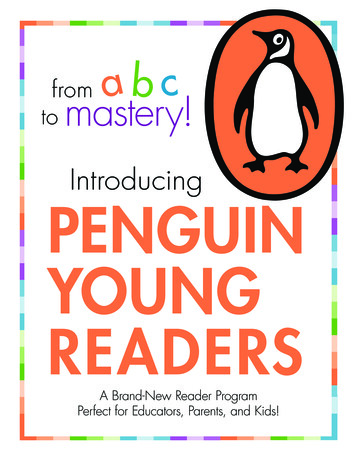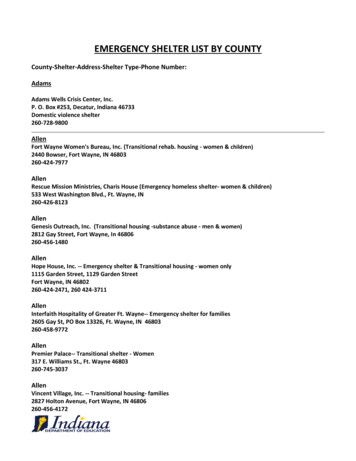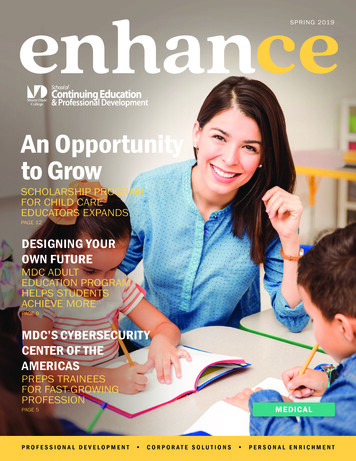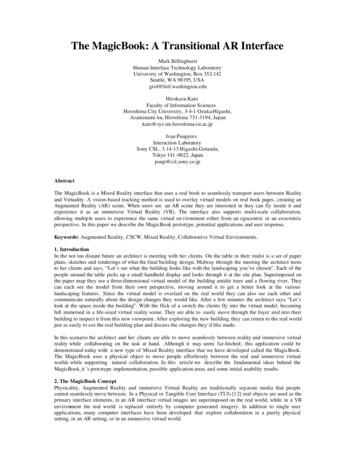
Transcription
The MagicBook: A Transitional AR InterfaceMark BillinghurstHuman Interface Technology LaboratoryUniversity of Washington, Box 352-142Seattle, WA 98195, USAgrof@hitl.washington.eduHirokazu KatoFaculty of Information SciencesHiroshima City University, 3-4-1 Ozuka-Higashi,Asaminami-ku, Hiroshima 731-3194, Japankato@sys.im.hiroshima-cu.ac.jpIvan PoupyrevInteraction LaboratorySony CSL, 3-14-13 Higashi-Gotanda,Tokyo 141 -0022, Japanpoup@csl.sony.co.jpAbstractThe MagicBook is a Mixed Reality interface that uses a real book to seamlessly transport users between Realityand Virtuality. A vision-based tracking method is used to overlay virtual models on real book pages, creating anAugmented Reality (AR) scene. When users see an AR scene they are interested in they can fly inside it andexperience it as an immersive Virtual Reality (VR). The interface also supports multi-scale collaboration,allowing multiple users to experience the same virtual en vironment either from an egocentric or an exocentricperspective. In this paper we describe the MagicBook prototype, potential applications and user response.Keywords: Augmented Reality, CSCW, Mixed Reality, Collaborative Virtual Environments.1. IntroductionIn the not too distant future an architect is meeting with her clients. On the table in their midst is a set of paperplans, sketches and renderings of what the final building design. Midway through the meeting the architect turnsto her clients and says, “Let’s see what the building looks like with the landscaping you’ve chosen”. Each of thepeople around the table picks up a small handheld display and looks through it at the site plan. Superimposed onthe paper map they see a three-dimensional virtual model of the building amidst trees and a flowing river. Theycan each see the model from their own perspective, moving around it to get a better look at the variouslandscaping features . Since the virtual model is overlaid on the real world they can also see each other andcommunicate naturally about the design changes they would like. After a few minutes the architect says, “Let’slook at the space inside the building”. With the flick of a switch the clients fly into the virtual model, becomingfull immersed in a life-sized virtual reality scene. They are able to easily move through the foyer and into theirbuilding to inspect it from this new viewpoint. After exploring the new building, they can return to the real worldjust as easily to see the real building plan and discuss the changes they’d like made.In this scenario the architect and her clients are able to move seamlessly between reality and immersive virtualreality while collaborating on the task at hand. Although it may seem far-fetched , this application could bedemonstrated today with a new type of Mixed Reality interface that we have developed called the MagicBook.The MagicBook uses a physical object to move people effortlessly between the real and immersive virtualworlds while supporting natural collaboration. In this article we describe the fundamental ideas behind theMagicBook, it ’s prototype implementation, possible application areas and some initial usability results.2. The MagicBook ConceptPhysicality, Augmented Reality and immersive Virtual Reality are traditionally separate media that peoplecannot seamlessly move between. In a Physical or Tangible User Interface (TUI) [12] real objects are used as theprimary interface elements, in an AR interface virtual images are superimposed on the real world, while in a VRenvironment the real world is replaced entirely by computer generated imagery. In addition to single userapplications, many computer interfaces have been developed that explore collaboration in a purely physicalsetting, in an AR setting, or in an immersive virtual world.
Our work involves exploring transitions between interface types, both in single user and collaborativeapplications. There are many possible ways of classifying computer interfaces. As Milgram points out [20],computer interfaces can be placed along a continuum according to how much of the users environment iscomputer generated (figure 1). On this Reality-Virtuality line Tangible User Interfaces lie far to the left, whilecomputer-generated immersive virtual environments are placed at the rightmost extreme. In between areAugmented Reality interfaces where virtual imagery is added to the real world, and Augmented Virtualityinterfaces where real world content is brought into immersive virtual scenes. Most current user interfaces can beplaced at specific points along this line.Figure 1: Milgram’s Reality-Virtuality Continuum.Similarly, Benford [4] classifies collaborative interfaces along two dimensions of Artificiality andTransportation. Transportation is the degree to which users leave their local space and enter into a remote space,and Artificiality the degree to which a space is synthetic or based on the physical world. Figure 2. shows theclassification of typical collaborative interfaces. As can be seen, Milgram’s continuum can be viewed as theequivalent of Benford’s Artificiality dimension. Again, most collaborative interfaces exist at a discrete locationin this two-dimensional taxonomy.Figure 2: Benford’s classification of Shared Spacs e according to Transportation and ArtificialityHowever, human activity often cannot be broken into discrete components and for many tasks users may preferto be able to easily switch between interfaces types, or co-located and remote collaboration . This is particularlytrue when viewing and interacting with three-dimensional graphical content. For example, even when using atraditional desktop modeling interface users will turn aside from the computer screen to sketch with pencil andpaper. As Kiyokawa et. al. point out, immersive VR and AR are complimentary and the type of interface shouldbe chosen according to the nature of the task [1 3]. For example if collaborators want to experience a virtualenvironment from different viewpoints or scale then immersive VR may be the best choice. However if thecollaborators want to have a face-t o-face discussion while viewing the virtual image an AR interface may bebest. Similarly in a collaborative session, users may often want to switch between talking with their remote
collaborators and the people sitting next to them in the same location. Given that different degrees of immersionmay be useful for different tasks and types of collaboration, an interesting question is how to support seamlesstransitions between the classification spaces.The MagicBook project is an early attempt to explore how a physical object can be used to smoothly transportusers between Reality and Virtuality, or between co-located and remote collaboration. Unlike other interfaces itcannot be placed as a discrete point on a taxonomy scale. In the remainder of this chapter we describe theMagicBook interface in more detail, the technology involved, initial user react ion and potential applications ofthe technology.3. The MagicBook ExperienceThe MagicBook interface uses normal books as the main interface objects. People can turn the pages of thesebooks, look at the pictures, and read the text without any additional technology (figure 3a). However, if theylook at the pages through an Augmented Reality display they see three -dimensional virtual models appearing outof the pages (figure 3b). The models appear attached to the real page so users can see the AR scene from anyperspective simply by moving themselves or the book. The models can be any size and are also animated, so theAR view is an enhanced version of a traditional three-dimensional “pop-up” book. Users can change the virtualmodels simply by turning the book pages and when they see a scene they particularly like, they can fly into thepage and experience the story as an immersive virtual environment (figure 3c). In the VR view they are free tomove about the scene at will and interact with the characters in the story. Thus, users can experi ence the fullReality-Virtuality continuum.3a: Reality3b: Augmented Reality3c: Immersive Virtual RealityFigure 3: Using the MagicBook interface to move between Reality andVirtual Reality.As can be seen the MagicBook interface has a number of important features:1/ The MagicBook removes the discontinuity that has traditionally existed between the real and virtual worlds.VR is a very intuitive environment for viewing and interacting with computer graphics content, but in a headmounted display (HMD) a person is separated from the real world and their usual tools, or collaborators. TheMagicBook enables people to move seamlessly between the real and virtual world and between co-located andremote collaborators.2/ The MagicBook interface allows users to view graphical content from both egocentric and exocentric views,so they can select the viewpoint appropriate for the task at hand. For exa mple an Augmented Reality viewpoint(exocentric view) may be perfect for viewing and talking about a model, but immersive VR (egocentric view) isbetter for experiencing the model at different scales or from different viewpoints. The MagicBook allows bothAR and VR views to be used in a single interface.3/ The computer interface has become invisible and the user can interact with graphical content as easily asreading a book. This is because the MagicBook interface metaphors are consistent with the form of the physicalobjects used. Turning a book page to change virtual scenes is as natural as rotating the page to see a differentside of the virtual models. Holding up the AR display to the face to see an enhanced view is similar to usingreading glasses or a magnifying lens. Rather than using a mouse and keyboard based interface users manipulatevirtual models using real physical objects and natural motions. Although the graphical content is not real, it looksand behaves like a real object, increasing ease of use. This ease of interaction could lead to radically new formsof entertainment and educational applications usable by a wider group of consumers and members of the public.
3.1 Collaboration with the MagicBookPhysical objects, Augmented Reality interfaces and immersive VR experiences each have different advantagesand disadvantages for supporting collaboration. As shown by Benford’s classification, there has been aproliferation of collaborative interfaces, but it has traditionally been difficult to move between the shared spacesthey create. For example, users in an immersive virtual environment are separated from the physical world andcannot collaborate with users in the real environment. The MagicBook supports all these types of interfaces andlets the user move smoothly between them depending on the task at hand.Real objects often serve as the focus for face to face collaboration and in a similar way the MagicBook interfacecan be used by multiple people at once. Several readers can look at the same book and share the story together(fig 4a). If these people then pick up their AR displays they will see the virtual models superimposed over thebook pages from their own viewpoint. Since they can see each other and the real world at the same time as thevirtual models they can easily communicate using normal face-to-face communiation cues. All of the usersusing the MagicBook interface have their own independent view of the content so any number of people canview and interact with a virtual model as easily as they could with a real object (fig. 4b).Figure 4a: Collaboration in the Real WorldFigure 4b: Sharing an AR ViewIn this way the MagicBook technology moves virtual content from the screen into the real world, preserving thecues used in normal face-to-face conversation, and providing a more intuitive technology for collaborativelyviewing three-dimensional virtual content.Multiple users can also be immersed in the virtual scene where they will see each other represented as virtualcharacters in the story (fig. 5a). More interestingly, there may be situations where one or more users areimmersed in the virtual world, while others are viewing the content as an Augmented Reality scene. In this casethe AR user will see an exocentric view of a miniature figure of the immersed user, moving as they movethemselves about the immersive world (figure 5b). Naturally, in the immersive world users viewing the ARscene appear as large virtual heads looking down from the sky. When users in the real world move, their virtualavatars move accordingly. In this way people are always aware of where the other users of the interface arelocated and where their attention is focused.Avatar5a: Avatar in a Immersive Scene5b: Avatar in an Exocentric AR viewFigure 5: Collaboration in the MagicBook
Thus the MagicBook interface supports collaboration on three levels: As a Physical Object: Similar to using a normal book, multiple users can read together. As an AR Object: Users with AR displays can see virtual objects appearing on the pages of the book. As an Immersive Virtual Space: Users can fly into the virtual space together and see each otherrepresented as virtual avatars in the story space.The interface also supports collaboration on multiple scales. Users can fly inside the virtual scenes (an egocentricview) and see each other as virtual characters, but a non -immersed user will also see the immersed users as smallvirtual characters on the book pages (an exocentric view). This means that a group of collaborators can shareboth egocentric and exocentric views of the same game or data set, leading to enhanced understanding .3.2. The MagicBook InterfaceThe MagicBook interface has three main components; a handheld Augmented Reality display (HHD), acomputer, and one or more physical books. The books look like any ordinary book and have no technologyembedded in them, while the display is designed to be easily held in one hand and to be as unencumbering aspossible.6a: The Hand Held Display6b: A MagicBook BookFigure 6: Components of the MagicBook InterfaceEach user has their own handheld display and computer to generate an individual view of the scenes. Thesecomputers are networked together or exchanging information about avatar positions and the virtual scene eachuser is veiwing. The handheld AR display is a handle with a Sony Glasstron PLM -A35 display mounted at thetop, an InterSense InterTrax [11] inertial tracker at the bottom, a small color video camera on the front of theGlasstron display and a switch and pressure pad embedded in the handle (figure 7). The PLM -A35 is a low costbioccular display with two LCD panels of 260x230 pixel resolution.Figure 7: The Handheld Display Components
The camera output is connected to the computer graphics workstation; computer graphics are overlaid on videoof the real world and resultant composite image shown back in the Glasstron display. In this way usersexperience the real world as a video-mediated reality. One advantages of this is that the video frames that arebeing seen in the display are exactly the same frames as those drawn on by the graphics software. This meansthat the registration between the real and virtual objects appears almost perfect because there is no apparent lagin the system. The video of the real world is actually delayed until the system has completed rendering the 3Dgraphics. On a mid range PC (866Mhz Pentium III) with a virtual scene of less than 10,000 polygons we canmaintain a refresh rate of 30 frames per second. This is fast enough that users perceive very little delay in thevideo of the real world and the virtual objects appear stuck to the real book pages.Although commercially available hardware was used in this interface, the “Opera glass” form factor of the handheld display was deliberately designed to encourage seamless transistion between Reality and Virtual Reality.Prior experience had taught us that many users are reluctant to wear head mounted displays, and that they areoften difficult to get on and off. Users can look through the display to see AR and VR content, but caninstantaneously return to viewing the real world simply by moving the display from in front of their eyes. Thehand held display is far less obtrusive and easy to remove that any head worn display, encouraging people tofreely transition along the Reality-Virtuality continuum. It is also easy to share, enabling several people to try asingle display unit and see the same content as they pass it amongst themselves. The form factor of the handleitself went through many design iterations (see figure 8) to ensure that the components could be mounted on it,that it would be comfortable to hold, and that it could be easily passed around.Figure 8. Alternative Handle DesignsThe books used in the MagicBook interface are normal books with text and pictures on each page. Certainpictures have thick black borders surrounding them and are used as tracking marks for a computer vision basedhead tracking system. When the reader looks at these pictures through the HHD, computer vision techniques areused to precisely calculate the camera position and orientation relative to the tracking mark. The head trackinguses the ARToolKit tracking library, a freely available open-source software package for developing visionbased AR applications [2]. Figure 9 summarizes how the ARToolKit tracking library works. Once the users headposition is known the workstation generates virtual images that appear precisely registered with the real pages.Our use of 2D markers for AR tracking is similar the CyberCode work presented by Rekimoto [24] and othervision based t racking systems.Figure 9: The ARToolKit Tracking Process
When the user sees an AR scene they wish to explore, flicking the switch on the handle will fly them smoothlyinto the scene, transitioning them into the immersive VR environment. In the VR scene users can no longer seethe real world and so the head tracking is changed from the computer vision module to the InterTrax inertialorientation tracker. The output from the InterTrax inertial compass is used to set the head orientation in thevirtual scene. The InterTrax provides three-degree of freedom orientation information with a high accuracy andvery little latency. Readers can look around the scene in any direction and by pushing the pressure pad on thehandle they can fly in the direction they’re looking. The harder they push the faster they fly. To return to the realworld users simply need to flick the switch again. The pressure pad and switch are both connected to a TNGinterface box [29] that converts their output to a single RS-232 serial data signal.The MagicBook application is also a networked application. Each of the user computers are networked togetherfor exchanging information about avatar positions and the virtual scene that each user is viewing. When usersare immersed in the virtual environment or are viewing the AR scenes their position and orientation is broadcastusing TCP/IP code to a central server application. The server application then re-broadcasts this information toeach of the networked computers and the MagicBook graphical client code. This is used to place virtual avatarsof people that are viewing the same scene, so users can collaboratively explore the virtual content. Since each ofthe client applications contain a complete copy of the graphics code, only a very small amount of informationneeds to be exchanged. Thus MagicBook applications can potentially support dozens of users. There is also noneed for users to be physically co-located. The virtual avatars can be controlled by users in the same location orremote from each other. So the MagicBook technology supports both face-to-face and remote collaboration.3.2 MagicBook ApplicationsTo encourage exploration in a number of different application areas we have developed the MagicBook as ageneric platform that can be used to show almost any VRML content. VRML is a standard file format for threedimensional computer graphics. We use an open source VRML rendering library called libVRML97 [21] that isbased on the OpenGL low -level graphics library. Since VRML is exported by most 3D modeling packages, it iseasy for content developers to build their own Magi cBook applications. In addition, there are hundreds ofthousands of VRML files freely available on the World Wide Web. Once the 3D content have been developed itis very simple to make the physical book pages and update the configuration files to load the correct content. Ina matter of a few hours a new MagicBook application can be made.This ease of development has resulted in the production of nearly a dozen books in a variety of applicationdomains. Among others, we have a Japanese children’s story that involves the reader in a treasure hunt, amacabre version of the Humpty Dumpty tale, a World War One History book, and a fanciful science fictionsnowboard experience that allows the reader to ski Mt. St. Helens after it erupts. These MagicBook applicationsexplore new literary ground where the reader can actually become part of the story and where the author mustconsider issues of interactivity and immersion.The MagicBook technology has also strong application potential for scientific visualization. We have begunexploring using this technology for viewing geo-spatial models. Figure 10 shows views of typical oilfieldseismic data superimposed over a tracking card. Currently petroleum comp anies deploy expensive projectionscreen based visualization centers around the world. The tracking systems used in the MagicBook interface arecompletely sourceless and so potentially mobile. In the near future it will be possible to run the MagicBooksoftware from a laptop computer and so support a radically new way of presenting visualisation data in a field.Figure 11: Seismic Data on a Tracking Marker
One of the more interesting applications is an educational textbook designed to teach architects how to buildGerrit Rietveld’s famous Red and Blue Chair (figure 11). After a brief introduction to Rietveld’s philosophy andconstruction techniques the readers are treated to a step -by-step instruction guide to building the chair. On eachpage is a two-dimensional picture of the current stage of the chair construction. When readers look at this page intheir hand-held displays, they see a three-dimensional model of the partially completed chair popping out ofpage. On the final page they see a virtual model of the completed chair that they can fly into and see life-sized.Being able see the chair from any angle during the construction process as well as a life-sized model at the end isa powerful teaching tool.Figure 11: Stages in building Gerrit Rietveld’s Red and Blue ChairIn a business setting each user could have their own independent view into the geo-spatial data set, and thenumber of users can be eas ily scaled to support both small and large group meetings. The opportunities forseeing private views of a shared dataset are particularly important when viewing sensitive data. The MagicBookgives engineers the ability to more naturally manipulate data sets and find obvious seismic features.Medical education is another natural application area. A group of medical students could be sitting around atable, seeing each other as well as a three-dimensional animated model of the heart floating over a picture in atextbook. They could then fly into the model and see what it would look like from the perspective of someonewalking through the four chambers. Medicine is an ideal application area for MagicBook technology because incurrent medical education textbooks and other 2D media to teach an inherently spatial subject.Perhaps the most near term application of the MagicBook technology is for games and entertainment. Asidefrom interactive stories the MagicBook platform could be used to extend many already popular games. Forexample, by looking at a chess board through AR glasses users could see animated models of the various pieces;placing two pieces side by side could cause the characters to battle, and the user could fly into the battle scene tosee it from a first person perspective.3.4 User Feedback“I think this is a great step towards immersive imagination.”“Great idea! I liked the handheld device.”“This is my favorite VR experience of the past few years - I like books and this "book extension" is really cool!”“Amazing mixed reality, the motion tracking was excellent and there are many possible applications of thetechnology.”“You can turn the pages and put your head in there. It is very easy to change orientation by walking and turningyour body. I loved the sense of control.”User Comments from Siggraph 2000
The MagicBook software was first shown at the Siggraph 2000 conference where over 2,500 people tried thebooks in the course of a week. Siggraph is a demanding environment to display an interactive experiencebecause attendees typically only have a few minutes and need to be able to master the technology immediately.Although we did not have time for a rigorous user study, 55 of these people filled out a simple survey about theirexperience. The quotes above come from Siggraph attendees.Feedback was very positive. People were able to use the interface with minimal training, they enjoyed the handheld displays, being able to view different AR scenes, and fly into the immersive VR worlds. Users felt that theinterface was easy and ituitive to use. They were given the question “How easily could you move between thereal and virtual worlds?”, and asked to respond on a scale of 1 to 7, where 1 was “not very easy” and 7 “veryeasy”. The average response was 5.9, and as the graph below (figure 12) shows users overwhelmingly felt theycould easily transition between the real and virtual worlds.Moving Between Reality and Virtual Reality18Number of Responses16141210864201234567Figure 12: How easy was it to move between Reality and Virtual Reality ? (7 very easy).However users felt that it was not as easy to collaborate with each other (figure 13). On a scale of 1 to 7 with 1being not very easy and 7 being very easy, the average response to the question “How easy was it to collaboratewith others?” was 3.4. This was probably due to many of the people trying the books by themselves, or whenusing it with another person not being aware of their avatar in the scene.How Easy was it to Collaborate ?16Number of Responses141210864201234567Figure 13: How easy was it to Collaborate? (1 not very easy, 7 very easy).Another area for potential improvement is in the navigation metaphor used. We modelled movement in theimmersive virtual world after movement in the real world and assumed that users would rarely want to move
backwards, since people rarely walk backwards. However it seems that users expected more of a video gamemetaphor and a majority of people immersed in the VR scenes asked how they could fly backwards. This issomething to be addressed in future versions of the interface.When asked what they liked most about the interface, users wrote that they most enjoyed the Augmented Realityscenes and the ability to fly into the virtual scenes. They were also impressed by the responsiveness of thecamera tracking and the interactivity of the experience. The most common responses are listed below.What did you like about the MagicBook exhibit?The Augmented Reality book scenes (8)How innovative and cool it was (8)The camera tracking (6)The idea (5)The abilty to fly into the virtual scenes (4)The interactivity (3)However users also felt that there were things that could be improved. They listed more realistic graphics, betteranimation and image quality as areas of concern. Many users also felt that movment through the virtual worldcould be improved, mostly because we did not allow users to move backwards. The most common responses arelisted below.What do you think could be improved in the MagicBook interface?The realism and complexity of the graphics content (16)Movement through the Virtual Space (8)The image quality (5)The latency in the graphics (4)The interactivity (3)Users were also asked to write what applications they could imagine this technology being used for. Education(17 responses) and entertainment (11) were the most common responses, although people also thought this couldbe used as an interact ive book (5), for training (5), visualization (3) and even teleconferencing (3). Oneparticularly interesting suggested application was a reading comprehension system for children.4. Related WorkThe MagicBook project has arisen out of past work in Mixed Reality and CSCW interfaces developed by a widevariety of research groups. We are concerned with developing Augmented Reality technology to support face-t oface and remote collaboration, particularly for 3D CSCW. This section briefly reviews some of the prior researchin the fields of remote and face-t o-face collaboration that our work is built upon.Early attempts at supporting face-to-face collaboration with computers were based around computer conferencerooms. These were meeting rooms in which each of the participants sitting at a conference table had their owndesktop computer and a video projector was used to provide a public display space. One example is the Colabroom at Xerox [27] that was used to support small group face-t o-face meetings. Colab used a network onworkstations running distributed software applications designed to support brainstorming, document preparation,proposal evaluation and other collaborative processes. However there were very few successful computerconference rooms. One of the reasons for this is the discovery that collaborators work together better if they arefocussed on a common workspace. So user’s collaborating on separate workstations, even if they are side byside, do not perform as well as if they were huddled around a single machine [10].Building on the notion of the common workspace, Weiser developed the concept of Ubiquitous Computingwhere compu
The MagicBook is a Mixed Reality interface that uses a real book to seamlessly transport users between Reality and Virtuality. A vision-based tracking method is used to overlay virtual models on real book pages, creating an Augmented Reality (AR) scene. When users see an A

